“Madonna of Bruges” by Michelangelo – An Analysis
The exact details of the conception and creation of the Madonna of Bruges (1503 – 1506) by Michelangelo have been debated among scholars, but it is known as one of the artist’s first sculptures that traveled outside of Italy to Belgium. While it was maybe not as famous as his other artworks, it nonetheless claimed its own beauty and intrigue. Read more about this sculpture in the article below!
Artist Abstract: Who Was Michelangelo?
Michelangelo di Lodovico Buonarroti Simoni was born on March 6, 1475, in the village of Caprese in Arezzo, Florence. He died on 18 February 1564 in Rome. He was multitalented and excelled as a sculptor, painter, poet, and architect, also known as a polymath. He was one of the most well-known artists of his time with several biographies and commissions from Catholic Popes and wealthy families. He was also nicknamed as the “Divine One” because of his masterful and almost magical skill of artmaking, notably sculptures. Some of his famous artworks include the Pietà (1498 – 1499), David (1501 – 1504), and the majestic paintings of the Sistine Chapel in the Vatican City in Rome, for example, The Creation of Adam (1508 – 1512) and The Last Judgment (1534 – 1541).
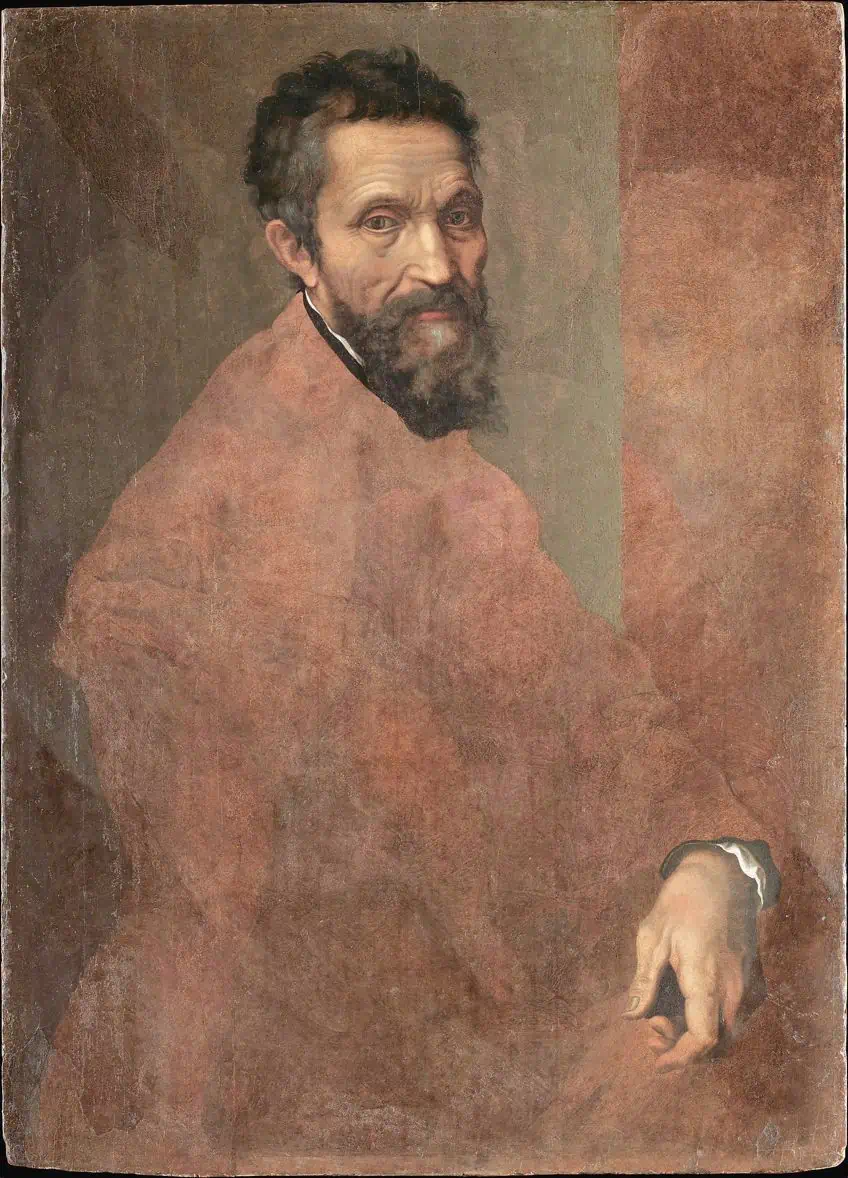
Madonna of Bruges (1503 – 1506) by Michelangelo in Context
| Artist | Michelangelo di Lodovico Buonarroti Simoni (1475 – 1564) |
| Date Painted | c. 1503 – 1506 |
| Medium | Marble |
| Genre | Sculpture |
| Period/Movement | High Renaissance |
| Dimensions (Meters) | Height: About two |
| Series/Versions | N/A |
| Where Is It Housed? | Church of Our Lady, Bruges, Belgium |
| What It Is Worth | It was reportedly bought by Giovanni and Alessandro Moscheroni in 1504 for 100 ducats (4,000 Florins). |
In the contextual analysis, you will read more about when the Madonna and Child sculpture by the famous Renaissance virtuoso, Michelangelo, was sculpted and some of its interesting adventures before it found its way to the Church of Our Lady in Bruges, Belgium. A formal analysis will discuss the sculpture in terms of the subject matter and primary art elements.
Contextual Analysis: A Brief Socio-Historical Overview
The Madonna of Bruges by Michelangelo was believed to have been completed between 1503 to 1506. There has also been minimal information about the sculpture’s commission, but it is believed that Michelangelo’s patrons were the Flemish Mouscron brothers, Jean and Alexander, who paid the artist 100 ducats. The Mouscron brothers were wealthy cloth merchants. Michelangelo reportedly started the sculpture in Carrara in Italy and after its completion, he was believed to have shipped it to Bruges in Belgium in 1506. Its purpose was believed to be for an altarpiece for the chapel that belonged to the Mouscron family in the Church of Our Lady.
There has been extensive scholarly debate around the purpose of the Bruges Madonna and Child, and according to some sources it was reportedly created to be in an enclosed recess that would be above the altar.
There are also reportedly carvings from Michelangelo’s chisel behind the Madonna and Child sculpture, which further emphasizes that it was possibly designed for a recessed space, or “niche”, which is how it is displayed in the church. This also points to the way Michelangelo depicted the Mother Mary and Jesus Christ. As some scholarly sources suggest, the child figure of Jesus is seemingly ready to walk down from standing between Mother Mary’s legs to the altar, which evokes the sacrificial symbolism associated with Jesus Christ and Mother Mary.
Formal Analysis: A Brief Compositional Overview
The formal analysis will describe Michelangelo’s Madonna sculpture titled, Madonna of Bruges, which is housed at the Church of Our Lady in the city of Bruges, Belgium. It will also discuss how the main art elements occur throughout the art piece that creates it.

Subject Matter: Visual Description
The Bruges Madonna and Child reportedly stands at two meters in height and is sculpted from a Carrara marble block. It depicts the Virgin Mary sitting while gazing downwards with an expression that appears similarly downcast. Her left foot (our right) is propped up higher than her right foot (our left), and her right hand rests loosely on her lap.
Nestled on the inside of Mother Mary’s propped-up left leg is the child figure of Jesus Christ, who is not lying down or sitting, but standing.
Mother Mary’s left hand is partly around Jesus Christ’s left side, and He is holding onto his mother’s left hand with his right hand, depicting his right arm reaching loosely in front of him. Jesus appears as if he is about to move out of his position and both appear somewhat emotionally detached from one another.
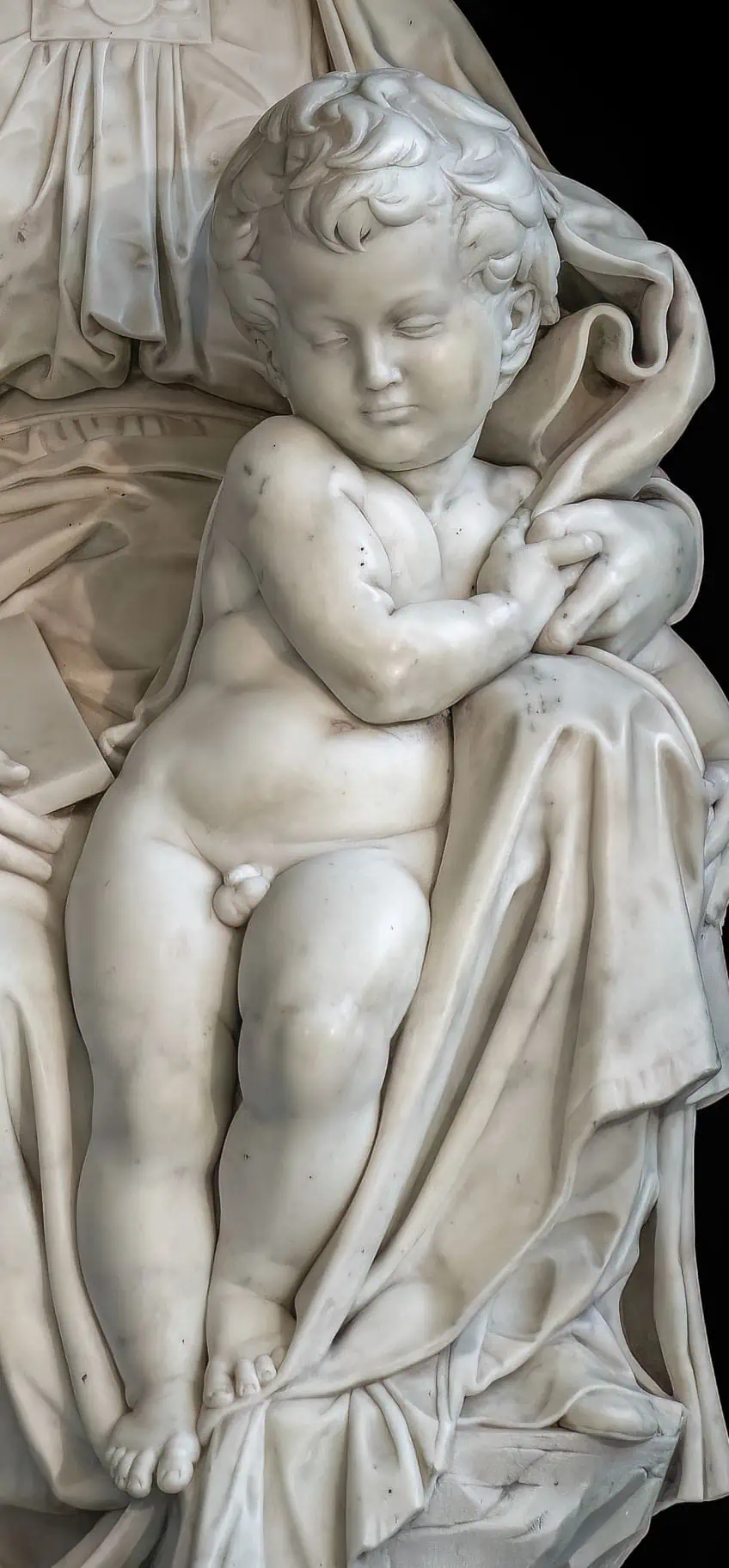
Color and Value
While Michelangelo’s Madonna and Child is a marble sculpture, the only color that occurs here is the white of the marble itself. It does not have any other colors painted onto it. The value of the art piece can also fluctuate due to changes in the lighting around the piece inside the church.
This could create darker, more shaded, areas or lighter areas where the light will find it.

Texture
The physical texture of the Madonna and Child sculpture appears smoothly carved, but Michelangelo was skillful in implying textures. For example, Mother Mary’s drapery appears soft and flowy in its folds as it hangs down to her feet.
Additionally, both figures’ skin and hair appear smooth and soft, notice the chubby texture of Jesus Christ’s revealed belly.
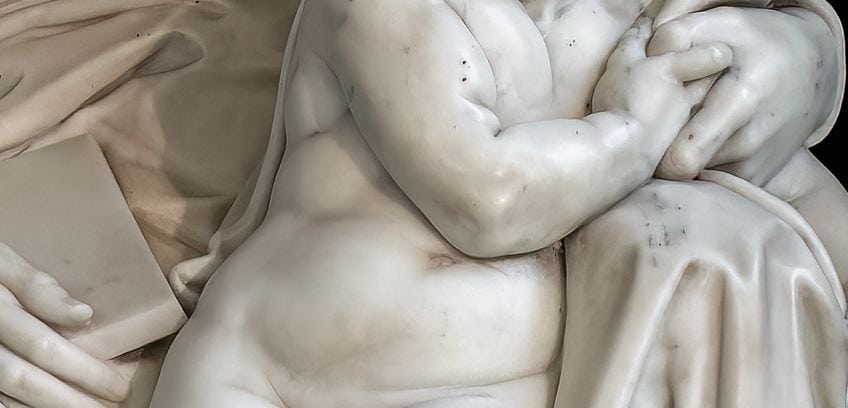
Line
The type of lines that occur in the Madonna of Bruges by Michelangelo are free-flowing and naturalistic, ranging from curved to diagonal lines that all create the figures’ contours. Notice the diagonal lines created by the folds of Mother Mary’s drapery.
This gives the sculptural composition a dynamism as if there is a sense of movement.

Shape and Form
Michelangelo’s Madonna and Child sculpture is a three-dimensional form because it can be viewed from multiple angles. The form is also naturalistic as it resembles a real-life depiction of figures. Additionally, Michelangelo also constructed the form of the sculpture in the pyramidal style.
While shapes appear two-dimensional, the type of shapes evident here is the circular shape on top of the rectangular shape that adorns Mother Mary’s dress around her upper chest area.
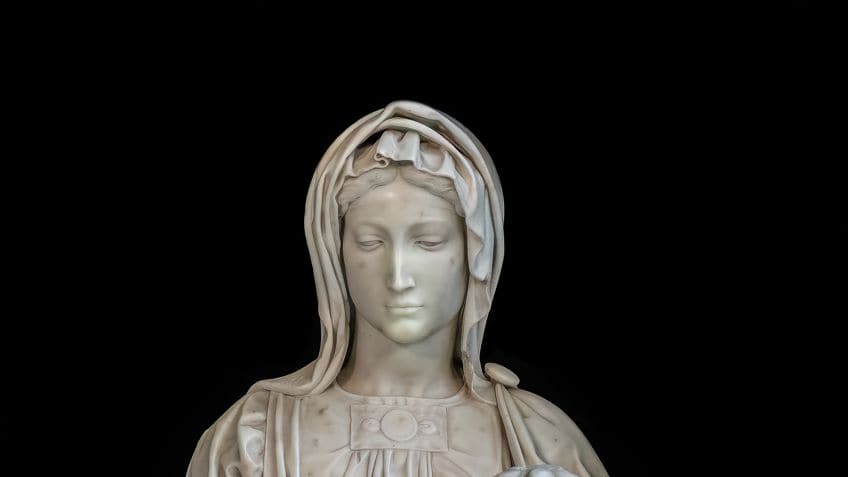
Space
The Madonna of Bruges by Michelangelo occupies a three-dimensional space because it has a width, height, and depth as compared to a canvas, which is two-dimensional with width and height. However, because it is in an enclosed recess in the wall, it can only be viewed from the front.
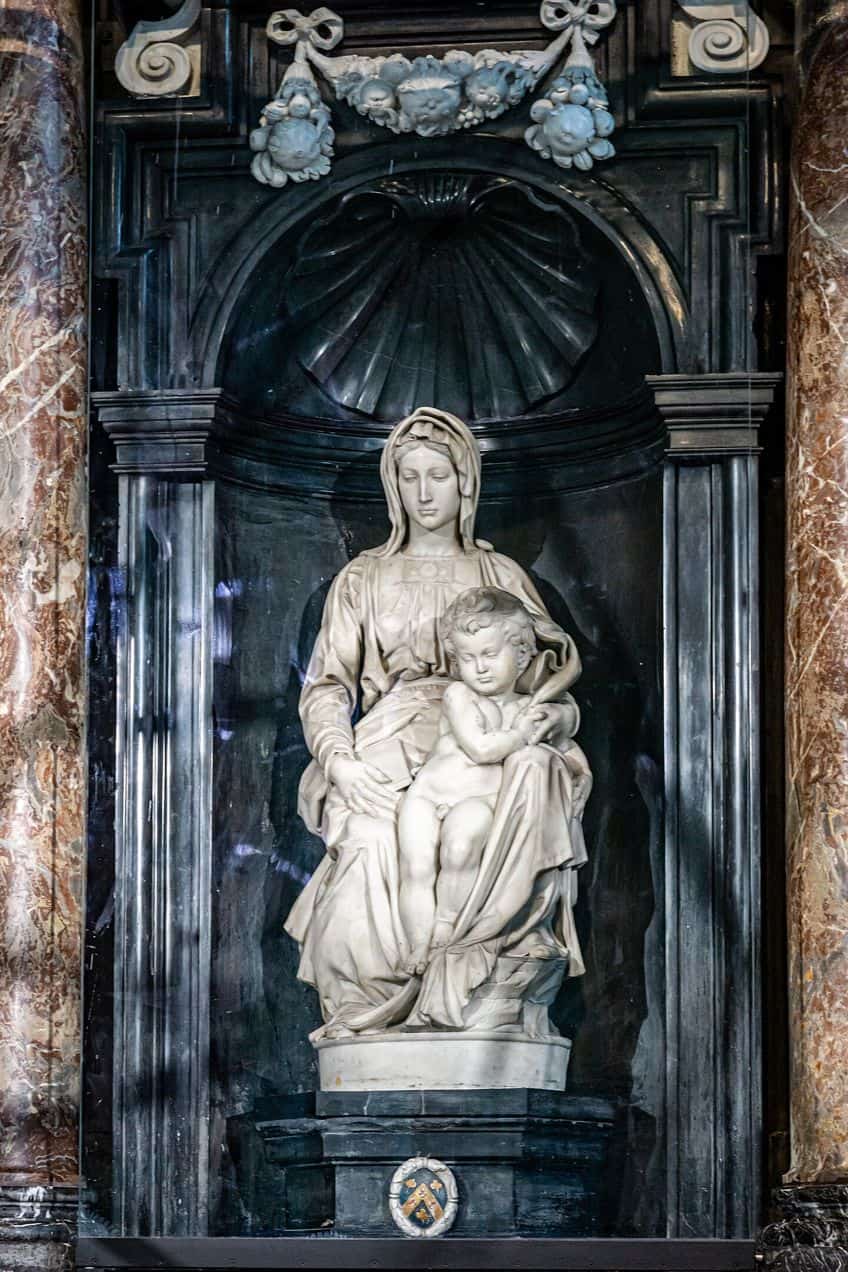
Michelangelo Turning Heads
Madonna of Bruges by Michelangelo was reportedly shipped to Paris in 1794 during the French Revolution, after which it was returned to its home in Bruges, only to be uprooted again in 1944, during World War II, when it was stolen by the German Nazi’s and stored in a salt mine. It was eventually returned to Bruges, and its tale became part of the movie titled The Monuments Men (2014), which was about the recovery of stolen artworks by the Nazis during World War II.

The Madonna of Bruges by Michelangelo has not received the same admiration as that of the artist’s other sculptures, such as the beloved Pietà (1498 – 1499), of which the two sculptures shared similar stylistic elements. It has nonetheless had a tale of its own, and Michelangelo’s depiction of one of the most popular Renaissance imageries, the Madonna and Child, certainly turned heads and raised questions about its meaning.
Frequently Asked Questions
Who Created the Bruges Madonna and Child?
The High Renaissance artist, Michelangelo di Lodovico Buonarroti Simoni, created the marble sculpture of the Madonna and Child between 1503 and 1506. It reportedly measures around 128 centimeters and is around two meters in height.
Where Is the Madonna and Child Sculpture by Michelangelo?
The marble sculpture by Michelangelo of the Madonna and Child is held at the Church of Our Lady in Bruges, Belgium, and is titled Madonna of Bruges (1503 – 1506). It was interestingly the artist’s first sculpture that did not stay in Italy and traveled outside of the country.
What Makes Michelangelo’s Madonna of Bruges Different?
Michelangelo depicted the marble sculpture, Madonna of Bruges (1503 – 1506), with Jesus Christ standing by the Virgin Mary and not held by her, as was commonly depicted. Furthermore, the Virgin Mary’s gaze is somewhat detached from both the scene and her child.
Jordan Anthony is a Cape Town-based film photographer, curator, and arts writer. She holds a Bachelor of Art in Fine Arts from the University of the Witwatersrand, Johannesburg, where she explored themes like healing, identity, dreams, and intuitive creation in her Contemporary art practice. Jordan has collaborated with various local art institutions, including the KZNSA Gallery in Durban, the Turbine Art Fair, and the Wits Art Museum. Her photography focuses on abstract color manipulations, portraiture, candid shots, and urban landscapes. She’s intrigued by philosophy, memory, and esotericism, drawing inspiration from Surrealism, Fluxus, and ancient civilizations, as well as childhood influences and found objects. Jordan is working for artfilemagazine since 2022 and writes blog posts about art history and photography.
Learn more about Jordan Anthony and about us.
Cite this Article
Jordan, Anthony, ““Madonna of Bruges” by Michelangelo – An Analysis.” artfilemagazine – Your Online Art Source. November 1, 2023. URL: https://artfilemagazine.com/madonna-of-bruges-by-michelangelo/
Anthony, J. (2023, 1 November). “Madonna of Bruges” by Michelangelo – An Analysis. artfilemagazine – Your Online Art Source. https://artfilemagazine.com/madonna-of-bruges-by-michelangelo/
Anthony, Jordan. ““Madonna of Bruges” by Michelangelo – An Analysis.” artfilemagazine – Your Online Art Source, November 1, 2023. https://artfilemagazine.com/madonna-of-bruges-by-michelangelo/.


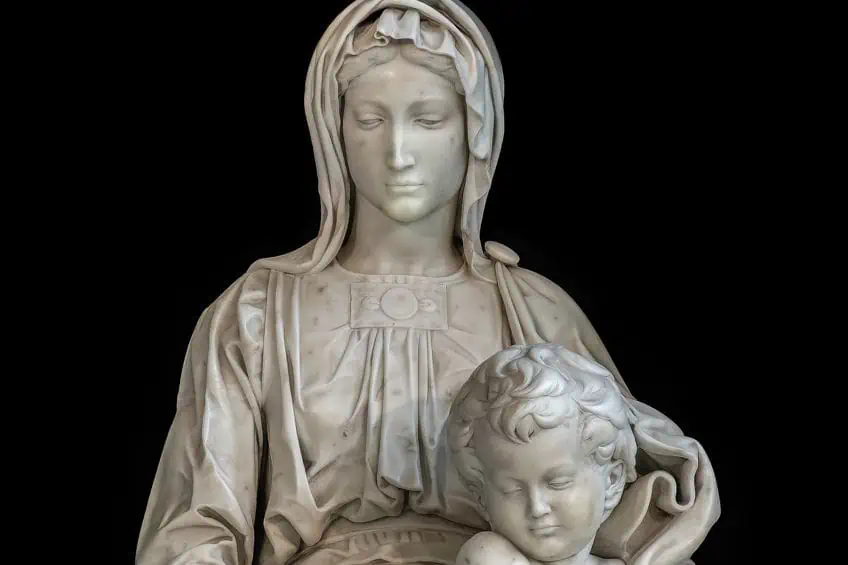

What is Mary holding in her right hand?
The Madonna of Bruges by Michelangelo is holding a booklet or book in her right hand.